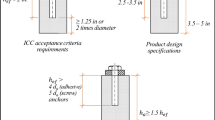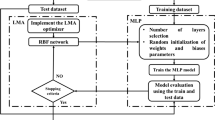Abstract
Bond deterioration between the reinforcement and surrounding concrete is one of the crucial reasons for the structural degradation in the steel–concrete composite structures. The assessment of bond deterioration due to corrosion is of prime importance on this issue. This study aims to present the derivation of analytical formulation of ultimate bond strength τ u at the corroded reinforcement–concrete interface for the reinforced concrete (RC) elements subjected to various levels of corrosion. The modeling technique dealt in this work is gene-expression programming and artificial neural network. The data used for the development of the models are thoroughly selected from the available experimental studies reported in the technical literature. A total of 218 experimental data samples were arranged to obtain training and testing data sets. The critical predictive factors were compressive strength of concrete, concrete cover, steel type, diameter of the steel bar, bond length, and corrosion level. The performances of the proposed empirical models were also evaluated statistically. The results indicated that the soft-computing based models had a satisfactory performance to predict the ultimate bond strength of corroded steel bars in RC elements.









Similar content being viewed by others
References
Almussallam AA, Al-Gahtani AS, Aziz AA, Rasheeduzzafar (1996) Effect of reinforcement corrosion on bond strength. Constr Build Mater 10(2):123–129
Auyeung Y, Balaguru P, Chung L (2000) Bond behaviour of corroded reinforcement bars. ACI Mater J 97(2):214–220
Shima H (2002) Local bond stress-slip relationship of corroded steel bars embedded in concrete. In: Proceeding of the third international symposium on bond in concrete, Budapest, pp 153–158. Nov 2002
Zhao Y, Jin W (2002) Test study on bond behavior of corroded steel bars and concrete. J Zhejiang Univ (Engineering Science Edition) 36(4):352–356 (in Chinese)
Fang C, Lundgren K, Chen L, Zhu C (2004) Corrosion influence on bond in reinforced concrete. Cem Concr Res 34(11):2159–2167
Horrigmoe G, Sæther I, Antonsen R, Arntsen B (2007) Laboratory investigations of steel bar corrosion in concrete. Background document SB3.10. Sustainable bridges: assessment for future traffic demands and longer lives. A project co-funded by the European Commission within the Sixth Framework Programme 2007
Chung L, Kim JHJ, Yi ST (2008) Bond strength prediction for reinforced concrete members with highly corroded reinforcing bars. Cem Concr Compos 30(7):603–611
Yalçıner H, Eren Ö, Serhan Ş (2012) An experimental study on the bond strength between reinforcement bars and concrete as a function of concrete cover, strength and corrosion level. Cem Concr Res 42(5):643–655
Al-Sulaimani GJ, Kaleemullah M, Basanbul IA, Rasheeduzzafar (1990) Influence of corrosion and cracking on bond behaviour and strength of reinforced concrete members. ACI Struct J 87(2):220–231
Fu X, Chung DDL (1997) Effect of corrosion on the bond between concrete and steel rebar. Cem Concr Res 27(12):1811–1815
Lee HS, Noguchi T, Tomosawa F (2002) Evaluation of the bond properties between concrete and reinforcement as a function of the degree of reinforcement corrosion. Cem Concr Res 32(8):1313–1318
Sather I (2011) Bond deterioration of corroded steel bars in concrete. Struct Infrastruct E 7(6):415–429
Ersoy U, Özcebe G, Tankut T (2010) Reinforced concrete. METU Press, Ankara
Andrade C, Alonso C, Molina FJ (1993) Cover cracking as a function of rebar corrosion: Part 1 Experimental test. Mater Struct 26(8):453–464
Rodriguez J, Ortega LM, Casal J, Diez JM (1996) Assessing structural conditions of concrete structures with corroded reinforcement. In: Proceedings of 4th international congress on concrete in service of mankind, Dundee
Güneyisi E, Gesoğlu M, Karaboğa F, Mermerdaş K (2012) Corrosion behaviour of reinforcing steel embedded in chloride contaminated concretes with and without metakaolin. Compos Part B 45(1):1288–1295
Güneyisi E, Özturan T, Gesoğlu M (2005) A study on reinforcement corrosion and related properties of plain and blended cement concretes under different curing conditions. Cem Concr Compos 27(4):449–461
Amleh L, Ghosh A (2006) Modeling the effect of corrosion on bond strength at the steel–concrete interface with finite-element analysis. Can J Civ Eng 33:673–682
Berto L, Simioni P, Saetta A (2008) Numerical modelling of bond behaviour in RC structures affected by reinforcement corrosion. Eng Struct 30:1375–1385
Topçu İB, Boğa AR, Hocaoğlu FO (2009) Modeling corrosion currents of reinforced concrete using ANN. Automat Constr 18(2):145–152
Lim CH, Yoon YS, Kim JH (2004) Genetic algorithm in mix proportioning of high performance concrete. Cem Concr Res 34(3):409–420
Fairbairn EMR, Silvoso MM, Filho RDT, Alves JLD, Ebecken NFF (2004) Optimization of mass concrete construction using genetic algorithms. Comput Struct 82(2–3):281–299
İnan G, Göktepe AB, Ramyar K, Sezer A (2007) Prediction of sulfate expansion of PC mortar using adaptive neuro-fuzzy methodology. Build Environ 42(3):1264–1269
Topçu İB, Sarıdemir M (2007) Prediction of properties of waste AAC aggregate concrete using artificial neural network. Comput Mater Sci 41(1):117–125
Topçu İB, Sarıdemir M (2008) Prediction of compressive strength of concrete containing fly ash using artificial neural networks and fuzzy logic. Comput Mater Sci 41(3):305–311
Adhikary BB, Mutsuyoshi H (2006) Prediction of shear strength of steel fiber RC beams using neural networks. Constr Build Mater 20(9):801–811
Mermerdaş K, Güneyisi E, Gesoğlu M, Özturan T (2013) Experimental evaluation and modeling of drying shrinkage behavior of metakaolin and calcined kaolin blended concretes. Constr Build Mater 43:337–347
Duan ZH, Kou SC, Poon CS (2013) Prediction of compressive strength of recycled aggregate concrete using artificial neural networks. Constr Build Mater 40:1200–1206
Ashour AF, Alvarez LF, Toropov VV (2003) Empirical modeling of shear strength RC deep beams by genetic programming. Comput Struct 81(5):331–338
Goh ATC (1995) Prediction of ultimate shear strength of deep beams using neural networks. ACI Struct J 92(1):28–32
Sadowski L (2013) Non-destructive investigation of corrosion current density in steel reinforced concrete by artificial neural networks. Arch Civ Mech Eng 13(1):104–111
Sadowski L (2010) Non-destructive evaluation of the pull-off adhesion of concrete floor layers using rbf neural network. J Civ Eng Manag 19(4):550–560
Sakla SSS, Ashour AF (2005) Prediction of tensile capacity of single adhesive anchors using neural networks. Comput Struct 83:1792–1803
Dahou Z, Sbartai ZM, Castel A, Ghomari F (2009) Artificial neural network model for steel-concrete bond prediction. Eng Struct 31(8):1724–1733
Golafshani EM, Rahai A, Sebt MS, Akbarpour H (2012) Prediction of bond strength of spliced steel bars in concrete using artificial neural network and fuzzy logic. Constr Build Mater 36:411–418
Eurocode 2: ZESIGN of concrete structures - Part 1-1: General rules and rules for buildings. EN 1992-1-1 Europian Committee for Standardization. British Standards Institution 2004
Midness S, Young JF, Darwin D (2003) Concrete, 2nd edn. Prentice Hall, New Jersey
FIB (2001) Punching of structural concrete slabs. Fib Bulletin 12, Technical report, Lausanne
Zadeh LA (1994) Soft computing and fuzzy logic. IEEE Softw 11(6):48–56
Koza JR (1991) Genetic programming: On the programming of computers by means of natural selection. MIT Press, Cambridge
Ferreira C (2001) Gene expression programming: a new adaptive algorithm for solving problems. Complex Syst 13(2):87–129
GeneXprotools 5.0. http://www.gepsoft.com/. 2015
Gao S, Zhang Z, Cao C (2011) Road traffic freight volume forecast using support vector machine combining forecasting. J Softw 6(9):1680–1687
Alexhander I, Morton H (1993) Neurons and symbols: the staff that mind is made of. Chapman and Hall, London
Arbib MA (1995) Handbook of brain theory and NN. MIT Press, Cambridge
Anderson JA (1995) An introduction to neural networks. A Bradford Book, MIT Press, Cambridge
Mukherjee A, Biswas SN (1997) Artificial neural networks in prediction of mechanical behavior of concrete at high temperature. Nucl Eng Des 178(1):1–11
Topçu İB, Sarıdemir M (2008) Prediction of mechanical properties of recycled aggregate concretes containing silica fume using artificial neural networks and fuzzy logic. Comput Mater Sci 42(1):74–82
MatlabV.R2012a. http://www.mathworks.com/help/. 2015
Author information
Authors and Affiliations
Corresponding author
Rights and permissions
About this article
Cite this article
Güneyisi, E.M., Mermerdaş, K. & Gültekin, A. Evaluation and modeling of ultimate bond strength of corroded reinforcement in reinforced concrete elements. Mater Struct 49, 3195–3215 (2016). https://doi.org/10.1617/s11527-015-0713-4
Received:
Accepted:
Published:
Issue Date:
DOI: https://doi.org/10.1617/s11527-015-0713-4




